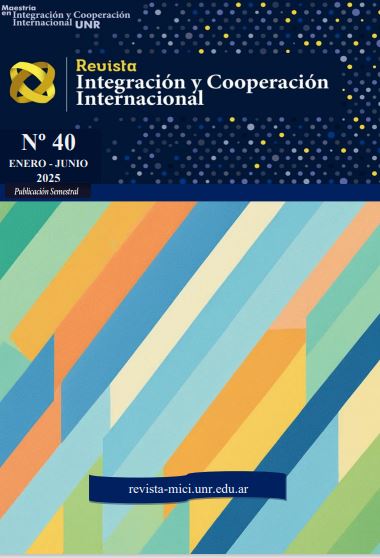Rumichaca, Darién y Río Bravo, un análisis conceptual de frontera
DOI:
https://doi.org/10.35305/revistamici.vi40.171Keywords:
Borders, Human mobility, Rumichaca, Darién y Río BravoAbstract
Borders are not simply dividing lines between nations; they are spaces of interaction, resistance and transformation where multiple social, political and economic dimensions converge. The border crossings of Rumichaca, on the border between Ecuador and Colombia; the Darien, in the area that separates Colombia from Panama; and the Rio Bravo, between Mexico and the United States, are examples of how borders function as devices that organize human mobility. In this article, the dynamics of these three border crossings are explored in an analogous way from a theoretical perspective with a literature review methodology, approaching the concept of border in the light of authors such as Étienne Balibar, Grimson, among others Sandro Mezzadra and Brett Neilson. The first section analyzes the border from a historical and dynamic concept, and then delves into its interaction with the nation-state and human mobility, essential elements in the contemporary analysis of borders. It will also analyze how borders function as spaces of power, where governments impose hierarchies and control, but also as places of resistance and transformation, where communities challenge restrictive policies. It will also address the issue of security in the contemporary context, considering global implications and current challenges. Finally, it will examine how globalization affects migrant families, transforming borders into a place of resistance and transformation, where communities challenge restrictive policies.
Downloads
References
ÁLVAREZ VELASCO, S., NAVARRO ALVARADO, G. y ECHEVERRI ZULUAGA, J. (2024). “Nunca vi el Darién cerrado”: transformaciones de la circulación por el corredor migratorio Región Andina-Centroamérica. Revista Común. https://revistacomun.com/blog/nunca-vi-el-darien-cerrado-transformaciones-de-la-circulacion-por-el-corredor-migratorio-region-andina-centroamerica/
ANGUIANO TÉLLEZ, M. E. (2003). Clandestinos: Migración México-Estados Unidos en los albores del siglo XXI. Migraciones internacionales, 2(2), 197-202. Doi: https://doi.org/10.17428/rmi.v2i5.1257
ARENDT, H. Nosotros, los refugiados. 1968. https://seminariopoliticayfilosofia.wordpress.com/wp-content/uploads/2019/02/hannah_arendt_nosotros-los-refugiados.pdf
EL ESPECTADOR (2013). Calzada entre Pasto y Rumichaca: solución para una frontera competitiva. https://www.elespectador.com/colombia/mas-regiones/calzada-entre-pasto-y-rumichaca-solucion-para-una-frontera-competitiva-article-440328/.
BBC NEWS MUNDO (S.F.). El mapa y las imágenes que muestran cómo es el muro que ya existe en la frontera entre México y Estados Unidos. https://www.bbc.com/mundo/noticias-internacional-46828540
BALIBAR, E. (2005). Fronteras del mundo, fronteras de la política. Alteridades, 15(30). https://www.redalyc.org/pdf/747/74703008.pdfv
CAMPESI, G. (2012). Migraciones, seguridad y confines en la teoría social contemporánea. Crítica Penal y Poder, (3). https://dialnet.unirioja.es/servlet/articulo?codigo=6056683
CASTILLO RAMÍREZ, G. (2023). Autonomía de las migraciones: de la producción política de fronteras a las luchas migrantes. Migraciones Internacionales, 14. Doi: https://doi.org/10.33679/rmi.v1i1.2573
HERNÁNDEZ C., DELMY T., DÍAZ LOZANO J. A. y MAGALHÃES L. (2021). Vivir en la frontera. Ecología Política, (61), 4-8. https://www.jstor.org/stable/e27120350
DIESBACH DE ROCHEFORT, N. M. (2002). Frontera: ¿Muro divisorio o tejido de relaciones?. Estudios Fronterizos 3(5), 9-42. https://www.scielo.org.mx/scielo.php?script=sci_arttext&pid=S0187-69612002000100001
EFE NOTICIAS (2024). Tijuana se convierte en el principal cruce irregular a EE.UU. https://efe.com/mundo/2024-05-25/tijuana-se-convierte-en-el-principal-cruce-irregular-de-migrantes-de-mexico-a-ee-uu/
FÁBREGAS PUIG, A. (2003). Las fronteras en un mundo globalizado. Liminar. Estudios Sociales y Humanísticos, 1(1), 6-17. Doi: https://doi.org/10.29043/liminar.v1i1.120
GARDUÑO, E. (2017). Antropología de la frontera, la migración y los procesos transnacionales. Frontera Norte 15 (30), 65-90. Doi: https://doi.org/10.17428/rfn.v15i30.1511.
GRIMSON, A. (2000). Pensar fronteras desde las fronteras. Nueva Sociedad (170). https://nuso.org/articulo/pensar-fronteras-desde-las-fronteras/
GUIZARDI, M., LÓPEZ, E., NAZAL, E. y VALDEBENITO, F. (2017). Fronteras, género y patriarcado. Discusiones teóricas para replantear el transnacionalismo migrante. Límite. Revista Interdisciplinaria de Filosofía y Psicología, 12(38), 22-38. https://dialnet.unirioja.es/servlet/articulo?codigo=6625308
INEC. (2024). Boletín Técnico N°01-2023-REESI. Registro Estadístico de Entradas y Salidas Internacionales.
KAVANAGH, W. (1994). La naturaleza de las fronteras. Historia y Fuente Oral, (12): 7-9. https://www.jstor.org/stable/i27753438
LA BARBERA, M. C. (2020) Vivir entre fronteras: Vulnerabilidad y transformación de la identidad en la era de la globalización. Bajo Palabra, (23), 261-286. Doi: http://dx.doi.org/10.15366/bp.2020.23.010
MARÍN PÉREZ, A. A. Y MÉNDEZ CABRITA, C. M. (2020). Aproximación al fenómeno frontera y movilidad humana de venezolanos desde la dinámica del paso fronterizo Rumichaca en Ecuador. Dilemas contemporáneos: Educación, Política y Valores, 7(9), 1-23. Doi: https://doi.org/10.46377/dilemas.v33i1.2122
MEZZADRA, S. y NEILSON, B. (2016). La frontera como método, o la multiplicación del trabajo. Buenos Aires: Tinta Limón.
SAN MARTÍN SEGURA, D. (2019). Las lógicas de gobierno de lo fronterizo en el espacio Schengen. Revista CIDOB d'Afers Internacionals (122), 15-38. https://www.jstor.org/stable/10.2307/26843344.
Serrano, M. (2017). LA POLÍTICA DE LA FRONTERA. ENTREVISTA A SANDRO MEZZADRA Y BRETT NEILSON. Intus Legere Filosofía, 10, 91. doi: https://doi.org/10.15691/0718-5448Vol10Iss2a164
STANG, F. (2020). La frontera como intersticio: Reflexiones en torno a la violencia epistémica de las fronterizaciones. REMHU: Revista Interdisciplinar da Mobilidad Humana, 28(59). Doi: https://doi.org/10.1590/1980-85852503880005902
TAPIA LADINO, M. (2017). Las fronteras, la movilidad y lo transfronterizo: Reflexiones para un debate. Estudios fronterizos, 18(37), 61-80. Doi: https://doi.org/10.21670/ref.2017.37.a04.
ZAPATA-BARRERO, R. (2012). Teoría política de la frontera y la movilidad humana. Revista Española de Ciencia Política, (29): 39-66. https://recyt.fecyt.es/index.php/recp/article/view/37548
UNICEF (2024). Oficina País Panamá. Reporte de situación. https://www.unicef.org/media/151392/file/Panama-Humanitarian-SitRep-Children-Move-January-2024-ES.pdf
Downloads
Published
How to Cite
Issue
Section
License
Copyright (c) 2025

This work is licensed under a Creative Commons Attribution-ShareAlike 4.0 International License.








